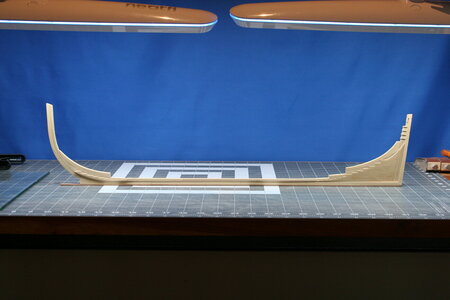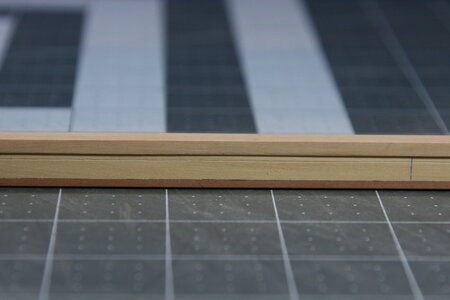I'm not sure about the worm, but I heard that they often called it shoes for simple reason, it can be replaced any time it wears out. It is much easier to replace the false keel than the keel itself.I found something like a worm shoe on keel? Maybe that's what it's about ?
You are using an out of date browser. It may not display this or other websites correctly.
You should upgrade or use an alternative browser.
You should upgrade or use an alternative browser.
POF L'Amarante Corvette de 12 canons 1744 1:36 (Ancre Monograph- Gérard Delacroix) By Shota
Hello Shota,
as Stephan, Jimy and Kuba have already correctly said, it is the false keel that protects the actual keel.
It is also correct that I haven't fitted it yet as all future plans are shown without the false keel. You will then have to subtract the 1.2mm each time you install the gunports or the beam travellers etc.
as Stephan, Jimy and Kuba have already correctly said, it is the false keel that protects the actual keel.
It is also correct that I haven't fitted it yet as all future plans are shown without the false keel. You will then have to subtract the 1.2mm each time you install the gunports or the beam travellers etc.
- Joined
- Apr 20, 2020
- Messages
- 5,151
- Points
- 738

my dear friendHello Shota,
as Stephan, Jimy and Kuba have already correctly said, it is the false keel that protects the actual keel.
It is also correct that I haven't fitted it yet as all future plans are shown without the false keel. You will then have to subtract the 1.2mm each time you install the gunports or the beam travellers etc.
First of all, thank you very much for your quick and helpful reply
I'm not sure I understood your explanation regarding the pre-installation of the false keel as you wrote in the following explanation:
"You will then have to subtract the 1.2mm each time you install the gunports or the beam travellers etc"
I would appreciate it if you could attach a picture and/or a drawing that would explain your words
- Joined
- Apr 20, 2020
- Messages
- 5,151
- Points
- 738

I know that below the keel of a dutch ship there is a strake over the lenght. It protects the keel and can be replaced after a while. This looks to me the same.
I once wondered about this too. it is a protective slide or strake as Steef66 wrote. View attachment 406313
My Dear friends,This part is called a false keel, The false keel was a timber, forming part of the hull of a wooden sailing ship. Typically 6 inches (15 cm) thick for a 74-gun ship in the 19th century, the false keel was constructed in several pieces, which were scarfed together, and attached to the underside of the keel by iron staples. The false keel was intended to protect the main keel from damage, and also protect the heads of the bolts holding the main keel together. The false keel could easily be replaced when it became damaged.
View attachment 406314
View attachment 406315
thank you all very much for the quick reply and the helpful explanations that help me a lot
 I think that there are problems with the transmission, I'll try to describe it more simply. Build it at the very end, then you won't have any problems with the following plans, because the false keel is not yet fitted there.
I think that there are problems with the transmission, I'll try to describe it more simply. Build it at the very end, then you won't have any problems with the following plans, because the false keel is not yet fitted there.- Joined
- Apr 20, 2020
- Messages
- 5,151
- Points
- 738

thanks my dear friend , Simplicity is bestI think that there are problems with the transmission, I'll try to describe it more simply. Build it at the very end, then you won't have any problems with the following plans, because the false keel is not yet fitted there.
At first , this is what I thought when I read your first explanation, but now I understand more clearly that I understood you correctly;
Pre-installation can lead to errors in the dimensional calculations of various parts of the ship, such as those based on drawings where the false keel is not included.
Wow, Shota I am excited to watch you new build. I plan on learning much from your project. Have fun and your friends are all in full support. Magic mike
- Joined
- Dec 3, 2018
- Messages
- 2,384
- Points
- 538

Here in Norway, the fake keel is called a worm board, a thick layer of tar was smeared between the keel and the board with the intention that the worms always attack the lower part of the keel first, it is, as previously said, much easier to replace.
Only my two cents in addition
The false keel was mainly to protect the keel from physical violence / damage - means damages caused by running aground or touching a reef etc.
So a wear and tear part
If the keel was damaged, the ship was more or less a total loss, but the false keel could me removed and repaired.
shoe maybe it was like a slipper house shoe ......
Very informative page:
The entire keel structure is actually made up of several layers of wood. They are (from bottom to top, starting above the keel block in the illustration below): 1) The white oak keel, which projects from the bottom of the vessel; 2) The live oak V-shaped floor timbers, which sit directly on top of the keel and are the beginning timbers for the ship’s frames; and 3) The white oak keelson that sits on top of the floor timbers, which on Constitution is actually made of two timbers–the keelson and upper keelson. Protecting the keel from physical damage is the sacrificial “false keel.” This six-inch layer of white oak is attached to the bottom of the keel and acts like a bumper, taking the impact if the ship runs aground. When Constitution ran aground off the south coast of England in January 1879, the false keel performed exactly as intended. Eighty-five feet of the false keel ripped away as the ship was released from her grounding, with no damage to the actual keel. Together, these layers of white and live oak measure about six feet high for the entire keel structure.
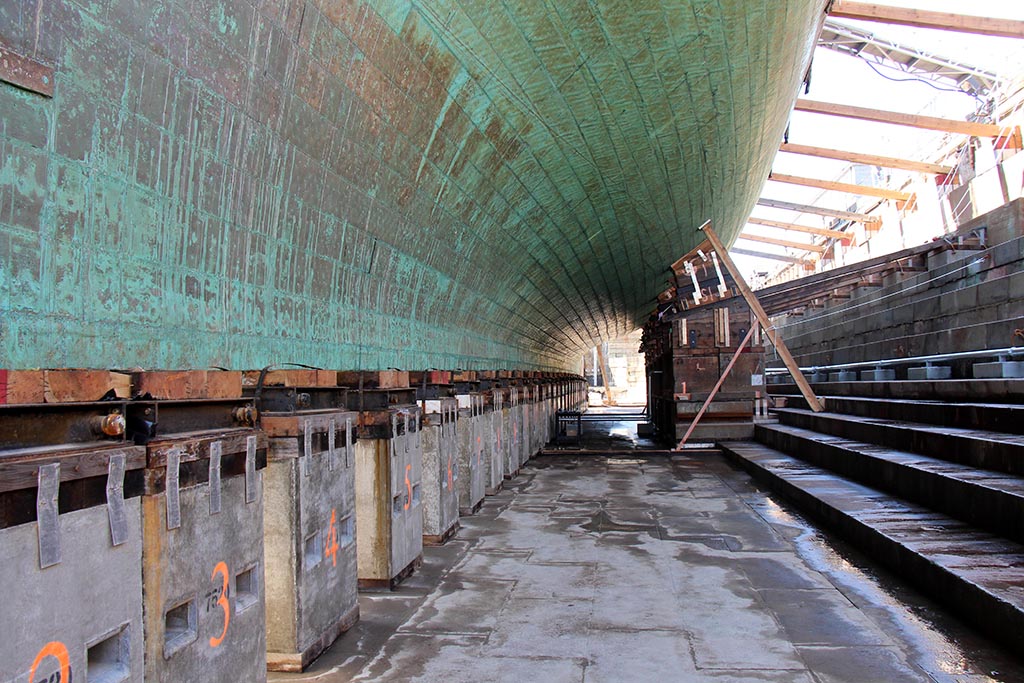
 ussconstitutionmuseum.org
ussconstitutionmuseum.org
BTW: also interesting is the fact, that either the fasle keel was extra sheated with copper, with a own row of sheating - this was also for easier repair
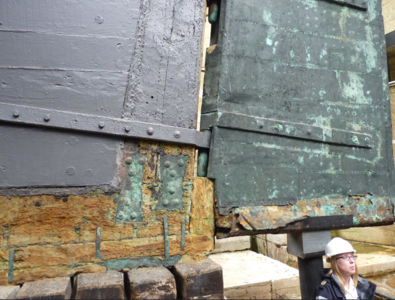
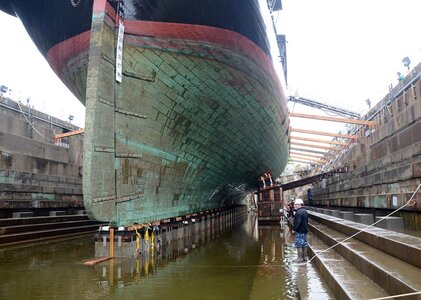
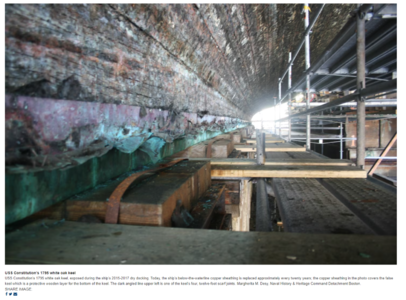
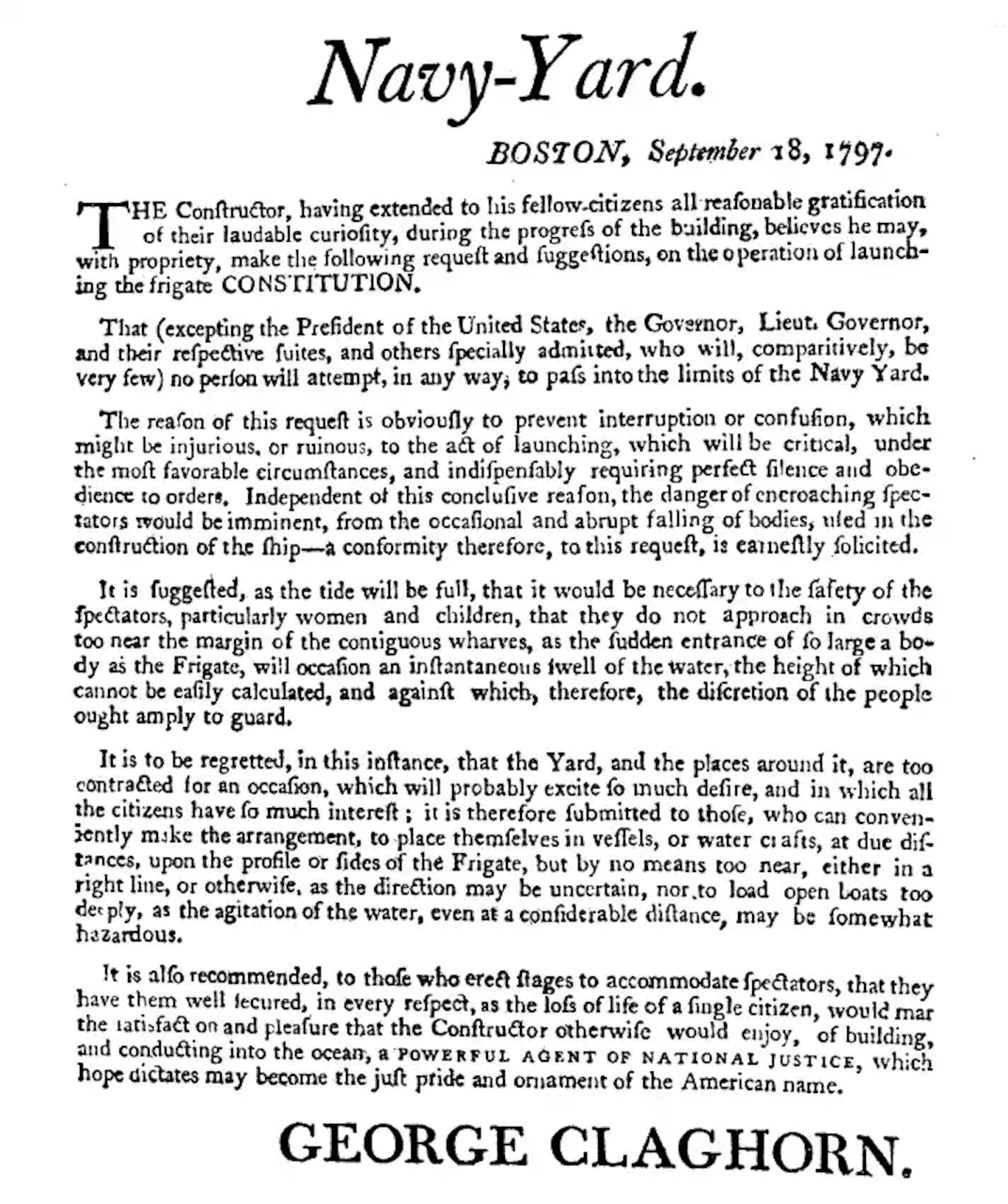
The false keel was mainly to protect the keel from physical violence / damage - means damages caused by running aground or touching a reef etc.
So a wear and tear part
If the keel was damaged, the ship was more or less a total loss, but the false keel could me removed and repaired.
shoe maybe it was like a slipper house shoe ......
Very informative page:
The entire keel structure is actually made up of several layers of wood. They are (from bottom to top, starting above the keel block in the illustration below): 1) The white oak keel, which projects from the bottom of the vessel; 2) The live oak V-shaped floor timbers, which sit directly on top of the keel and are the beginning timbers for the ship’s frames; and 3) The white oak keelson that sits on top of the floor timbers, which on Constitution is actually made of two timbers–the keelson and upper keelson. Protecting the keel from physical damage is the sacrificial “false keel.” This six-inch layer of white oak is attached to the bottom of the keel and acts like a bumper, taking the impact if the ship runs aground. When Constitution ran aground off the south coast of England in January 1879, the false keel performed exactly as intended. Eighty-five feet of the false keel ripped away as the ship was released from her grounding, with no damage to the actual keel. Together, these layers of white and live oak measure about six feet high for the entire keel structure.

Keel Hauled - USS Constitution Museum
On Saturday last [May 16, 1795], the keel of the United States frigate [Constitution]…was finished laying. It is 156 feet in length, and from the. . .
BTW: also interesting is the fact, that either the fasle keel was extra sheated with copper, with a own row of sheating - this was also for easier repair




“…she will be one of the finest vessels that ever floated” – The First Attempts to Launch
Editor’s Note: On May 10, 2022, Naval History and Heritage Command began commemorating the 225th anniversary of the launch of the first of the U.S. Navy’s six frigates (United States), which began the
usnhistory.navylive.dodlive.mil
- Joined
- Jan 30, 2023
- Messages
- 249
- Points
- 133

Only my two cents in addition
The false keel was mainly to protect the keel from physical violence / damage - means damages caused by running aground or touching a reef etc.
So a wear and tear part
If the keel was damaged, the ship was more or less a total loss, but the false keel could me removed and repaired.
shoe maybe it was like a slipper house shoe ......
Very informative page:
The entire keel structure is actually made up of several layers of wood. They are (from bottom to top, starting above the keel block in the illustration below): 1) The white oak keel, which projects from the bottom of the vessel; 2) The live oak V-shaped floor timbers, which sit directly on top of the keel and are the beginning timbers for the ship’s frames; and 3) The white oak keelson that sits on top of the floor timbers, which on Constitution is actually made of two timbers–the keelson and upper keelson. Protecting the keel from physical damage is the sacrificial “false keel.” This six-inch layer of white oak is attached to the bottom of the keel and acts like a bumper, taking the impact if the ship runs aground. When Constitution ran aground off the south coast of England in January 1879, the false keel performed exactly as intended. Eighty-five feet of the false keel ripped away as the ship was released from her grounding, with no damage to the actual keel. Together, these layers of white and live oak measure about six feet high for the entire keel structure.

Keel Hauled - USS Constitution Museum
On Saturday last [May 16, 1795], the keel of the United States frigate [Constitution]…was finished laying. It is 156 feet in length, and from the. . .ussconstitutionmuseum.org
BTW: also interesting is the fact, that either the fasle keel was extra sheated with copper, with a own row of sheating - this was also for easier repair
View attachment 406733
View attachment 406734
View attachment 406735

“…she will be one of the finest vessels that ever floated” – The First Attempts to Launch
Editor’s Note: On May 10, 2022, Naval History and Heritage Command began commemorating the 225th anniversary of the launch of the first of the U.S. Navy’s six frigates (United States), which began theusnhistory.navylive.dodlive.mil
Very valuable information. I noticed a separate covering false keel on the USS Constitutnion, so I decided to use a similar solution on my Nuestra Señora de Las Mercedes. I think this topic will bring a lot of valuable advice and tips. I'll keep watching with pleasure.
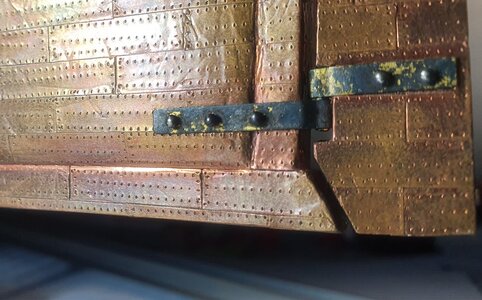
- Joined
- Apr 20, 2020
- Messages
- 5,151
- Points
- 738

thank you very much my dear friend for your great explanation and more than thatOnly my two cents in addition
The false keel was mainly to protect the keel from physical violence / damage - means damages caused by running aground or touching a reef etc.
So a wear and tear part
If the keel was damaged, the ship was more or less a total loss, but the false keel could me removed and repaired.
shoe maybe it was like a slipper house shoe ......
Very informative page:
The entire keel structure is actually made up of several layers of wood. They are (from bottom to top, starting above the keel block in the illustration below): 1) The white oak keel, which projects from the bottom of the vessel; 2) The live oak V-shaped floor timbers, which sit directly on top of the keel and are the beginning timbers for the ship’s frames; and 3) The white oak keelson that sits on top of the floor timbers, which on Constitution is actually made of two timbers–the keelson and upper keelson. Protecting the keel from physical damage is the sacrificial “false keel.” This six-inch layer of white oak is attached to the bottom of the keel and acts like a bumper, taking the impact if the ship runs aground. When Constitution ran aground off the south coast of England in January 1879, the false keel performed exactly as intended. Eighty-five feet of the false keel ripped away as the ship was released from her grounding, with no damage to the actual keel. Together, these layers of white and live oak measure about six feet high for the entire keel structure.

Keel Hauled - USS Constitution Museum
On Saturday last [May 16, 1795], the keel of the United States frigate [Constitution]…was finished laying. It is 156 feet in length, and from the. . .ussconstitutionmuseum.org
BTW: also interesting is the fact, that either the fasle keel was extra sheated with copper, with a own row of sheating - this was also for easier repair
View attachment 406733
View attachment 406734
View attachment 406735

“…she will be one of the finest vessels that ever floated” – The First Attempts to Launch
Editor’s Note: On May 10, 2022, Naval History and Heritage Command began commemorating the 225th anniversary of the launch of the first of the U.S. Navy’s six frigates (United States), which began theusnhistory.navylive.dodlive.mil
- Joined
- Apr 20, 2020
- Messages
- 5,151
- Points
- 738

good evening dear friends
In the last few days I continued to work on the Keel. I wish to say that the most of the parts have been prepared and even some of them have been glued, like the bow area.
I am proud of the way of creation the combination between the ebony wood in the bow and stern! I managed to connect the pear and the ebony in a way that highlights the beauty of the combination between them and when the point of connection is not prominent, but a flow and unity between the parts is visible. I would like to share two techniques I used to connect the pear and the ebony:
In the stern I made 3 holes with a diameter of about 2 mm and inserted a wooden toothpick into them and using clamps and wooden strips I maintained continuous connection and outline lines.
in the bow I used a different method, at the end of the ebony I left a rectangular bump/jutty at a height of 3.4 mm and in the pear I made a rectangular recess into which the bump goes. the socket in Ags was not along the entire length of these connection points up to a distance of 2 mm from the front end of the bow, so that the joint is visible when viewed from the front.
I recommend the second method because after gluing, the joining point is stronger and more beautiful in my opinion. I will attach photos for your impression (I have a lot of adjustments and finishing work left until I reach the required result in preparing the keel) good night dear friends
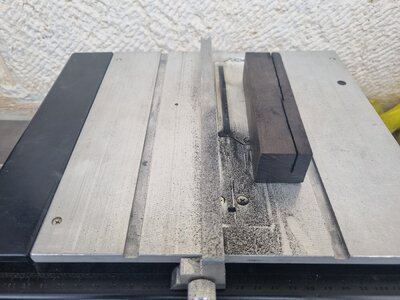
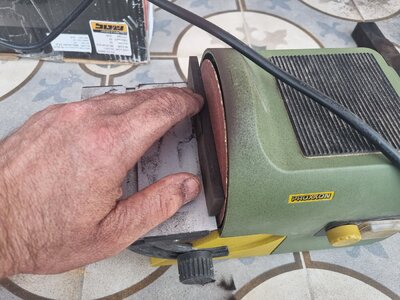
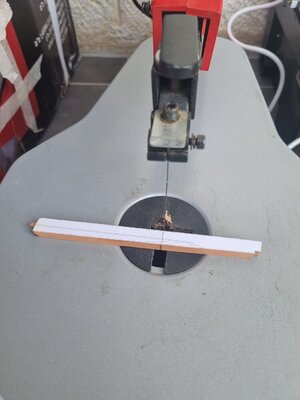
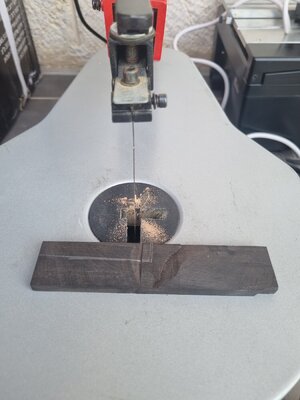
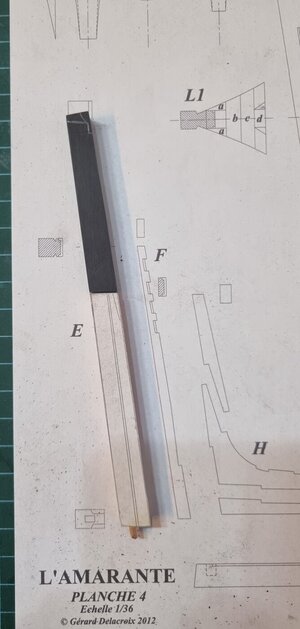
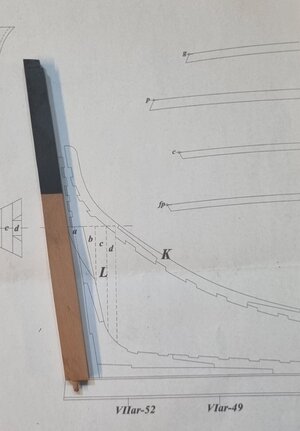
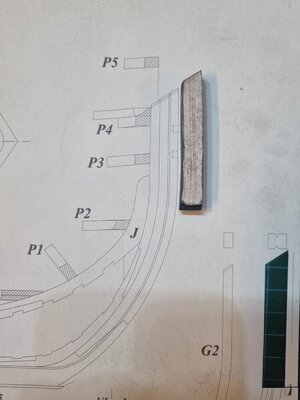
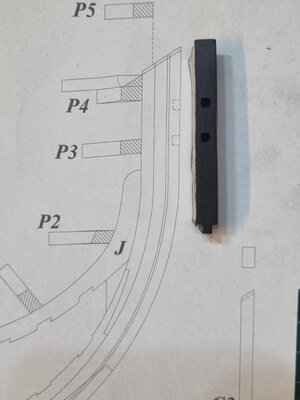
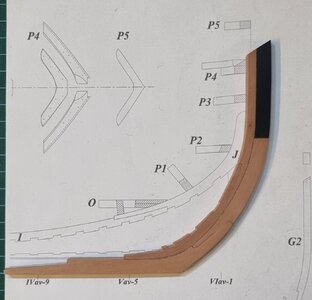
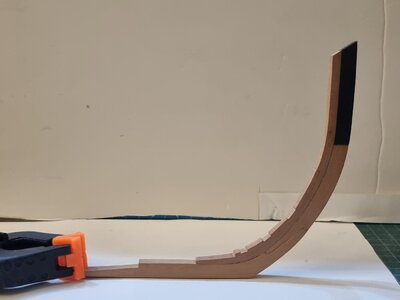
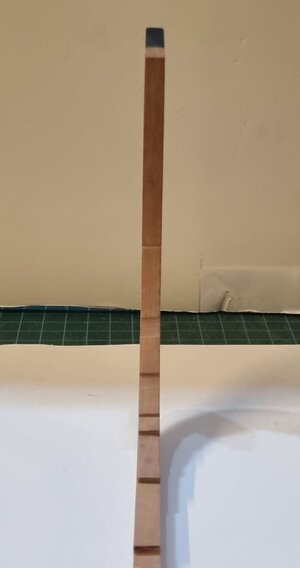
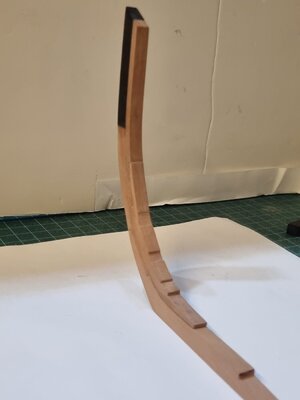
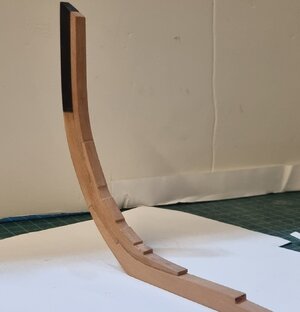
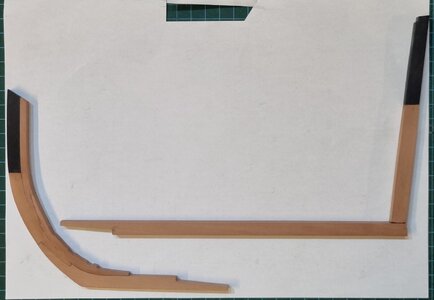
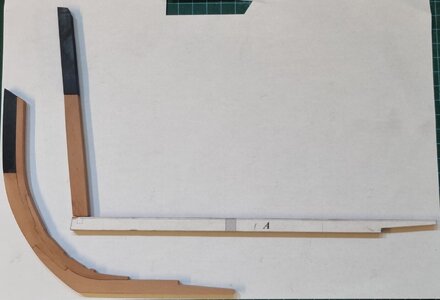
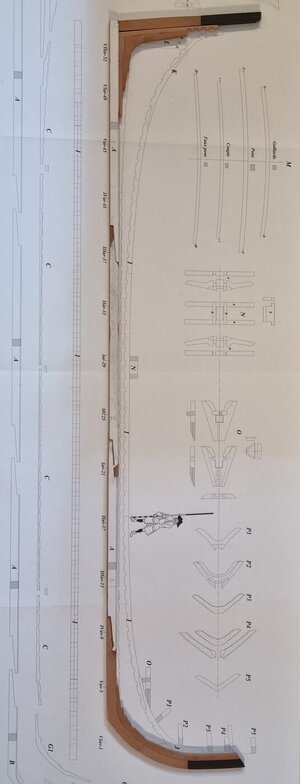
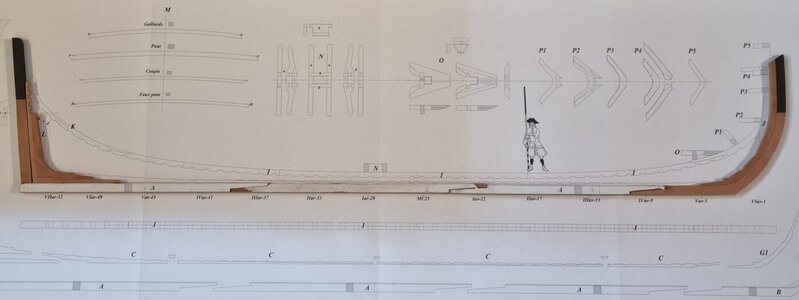
In the last few days I continued to work on the Keel. I wish to say that the most of the parts have been prepared and even some of them have been glued, like the bow area.
I am proud of the way of creation the combination between the ebony wood in the bow and stern! I managed to connect the pear and the ebony in a way that highlights the beauty of the combination between them and when the point of connection is not prominent, but a flow and unity between the parts is visible. I would like to share two techniques I used to connect the pear and the ebony:
In the stern I made 3 holes with a diameter of about 2 mm and inserted a wooden toothpick into them and using clamps and wooden strips I maintained continuous connection and outline lines.
in the bow I used a different method, at the end of the ebony I left a rectangular bump/jutty at a height of 3.4 mm and in the pear I made a rectangular recess into which the bump goes. the socket in Ags was not along the entire length of these connection points up to a distance of 2 mm from the front end of the bow, so that the joint is visible when viewed from the front.
I recommend the second method because after gluing, the joining point is stronger and more beautiful in my opinion. I will attach photos for your impression (I have a lot of adjustments and finishing work left until I reach the required result in preparing the keel) good night dear friends

















This is excellent work Shota. Wonderful joinery!
But please wear a mask when you are working with ebony. It contains toxins that can be an irritant...
But please wear a mask when you are working with ebony. It contains toxins that can be an irritant...
one more wood to this magnificent trio - is boxwood...and then oil and...Oh My...Wonderful work Shota! I agree with you. The Ebony and Pear look beautiful together.
Excellent work so far my friend,
- Joined
- Oct 23, 2018
- Messages
- 525
- Points
- 353

Very well done. I personally will never work with ebony.

